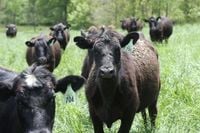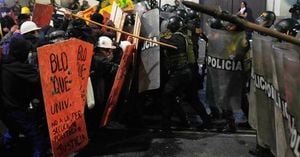Tempers are flaring in the American heartland as President Donald Trump’s plan to slash record beef prices by importing significantly more tariff-free meat from Argentina has set off a storm of criticism from U.S. cattle ranchers—one of his most reliable bases of support. The rift, which deepened on October 22, 2025, has drawn in lawmakers, industry groups, and watchdog organizations, all weighing in as beef prices soar and political stakes mount.
The controversy erupted after Trump announced the U.S. would quadruple its tariff-rate quota for Argentine beef to 80,000 metric tons, exempting it from the usual 26.4% tariffs. According to Bloomberg, this move is part of the administration’s effort to bring relief to American consumers facing sticker shock at the grocery store. But for many ranchers, the solution is not just unpalatable—it’s potentially disastrous.
On his Truth Social platform, Trump did not mince words. “If it weren’t for me, they would be doing just as they’ve done for the past 20 years—Terrible! It would be nice if they would understand that,” he wrote, referencing U.S. cattlemen. He doubled down, insisting that ranchers should be grateful for his tariff policies, which he claims have boosted their profits. But he also urged them to lower their own prices, adding, “the consumer is a very big factor in my thinking, also!”
American cattle ranchers, for their part, are pushing back hard. The National Cattlemen’s Beef Association (NCBA), a major industry group, has made its position clear. “The National Cattlemen’s Beef Association and its members cannot stand behind the President while he undercuts the future of family farmers and ranchers by importing Argentinian beef in an attempt to influence prices,” said CEO Colin Woodall in a statement reported by UPI. “It is imperative that President Trump and Secretary of Agriculture Brooke Rollins let the cattle markets work.”
The numbers tell a sobering story. The cost of beef in the United States has hit record highs in 2025, rising 13.9% in August compared to a year earlier. The U.S. Department of Agriculture’s Economic Research Service predicts an 11.6% increase for the year—a sharp jump that’s left consumers grumbling and policymakers scrambling for solutions.
Trump’s plan, first floated to reporters aboard Air Force One earlier in October, is straightforward: import more beef from Argentina to increase supply and bring prices down. But ranchers argue the plan is misguided and harmful, with little chance of making a real dent in grocery bills. Instead, they say, it threatens the livelihoods of American producers already battered by years of drought, high input costs, and what they describe as a “rigged market.”
Argentina, led by Trump ally President Javier Milei, has been in the headlines for more than just beef. Earlier this month, the country secured a $20 billion financial bailout from the United States, a move that has drawn sharp criticism from American farmers—particularly soybean growers, who compete directly with Argentina in the lucrative Chinese export market. According to UPI, frustration is mounting over the fact that Argentina sold more than $801 million worth of beef into the U.S. market, while American beef exports to Argentina amounted to just $7 million.
Senate Republicans from ranching states have not been shy about voicing their concerns. Senate Majority Leader John Thune and others raised the issue directly with the president during a White House lunch on October 21, 2025. North Dakota Senator John Hoeven emphasized to Trump and his cabinet that ranchers want to be the ones to increase U.S. supply and bring down prices. Senator Steve Daines of Montana echoed this sentiment, telling Bloomberg, “The answer is let the markets continue to recover.” Daines noted that ranchers are “finally getting to the point where they’re making money again and they’re very concerned about these actions.”
The Agriculture Department, seeking to quell unrest, announced on October 22 that it would expedite regulatory reforms and boost processing capacity to help U.S. farmers weather the impact. “We are committed to ensuring the American people have an affordable source of protein and that America’s ranchers have a strong economic environment where they can continue to operate for generations to come,” said Agriculture Secretary Brooke Rollins in a statement.
But for many in the ranching community, these assurances ring hollow. The USDA also rolled out a voluntary Country of Origin Labeling (COOL) program to promote and protect American beef. However, groups like Farm Action, a nonpartisan agricultural watchdog, argue that voluntary labeling isn’t enough. They’re calling for mandatory country of origin labeling and investigations into the so-called “Big Four” meatpackers, whom they accuse of controlling beef prices and squeezing out independent ranchers. “Ranchers need support to rebuild their herds—that’s how we truly increase beef supply and lower prices long-term,” Farm Action said in a statement. “After years of drought, high input costs and selling into a rigged market, we deserve policies that strengthen rural America, not ones that reward foreign competitors and corporate monopolies.”
Wyoming’s Meriwether Farms echoed these demands, urging Trump to use his executive powers to institute mandatory country of origin labeling. “This is not good enough,” the farm said of the USDA’s initiatives.
Meanwhile, the political calculus is growing more complicated. Trump’s import tax policies, which have reached their highest levels in a century, have protected some American industries but also contributed to higher consumer prices—a contradiction that’s become increasingly hard to ignore. As Bloomberg points out, the president’s efforts to shield U.S. producers with tariffs have sometimes clashed with his campaign promise to curb inflation for everyday Americans.
At the heart of the matter is a fundamental question: Who should bear the burden of high beef prices—consumers, ranchers, or foreign competitors? Trump’s administration is betting that increased imports will offer relief at the checkout counter, but many ranchers see the move as a threat to their future. As the debate rages on, both sides are digging in, with ranchers insisting on market-based solutions and stronger protections for U.S. producers, while the White House remains focused on consumer costs and global trade partnerships.
As the dust settles, one thing is clear: the battle over beef has become a flashpoint in the broader struggle over trade, agriculture, and the future of rural America. Whether compromise is possible remains to be seen, but for now, the stakes—for ranchers, consumers, and politicians alike—could hardly be higher.




